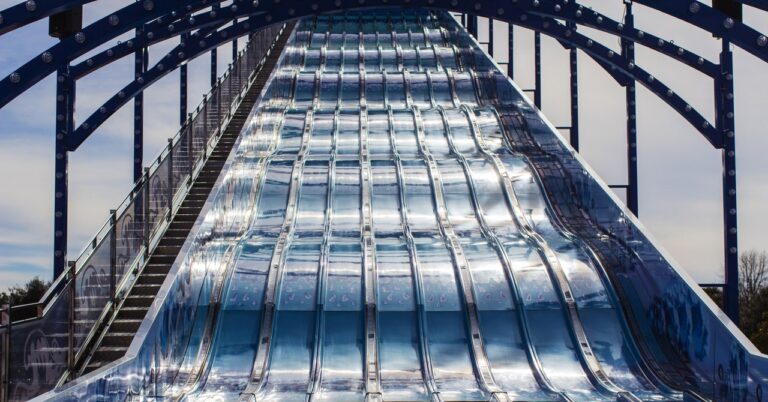
[ad_1]
Really, the only difference is that this is a downward-curving path with the center of this circular curve below the slide instead of above. (Once again, the gray C-shape represents the path of the rider on the slide and the circular trajectory of their body, and the dot is the center of the circle.) That means the centripetal acceleration is also in the downward direction and towards the center of the circle.
Since the acceleration switched directions, the normal force (N) has to be less than the radial component of the gravitational force, which is pulling the person downward toward the Earth. What happens when the normal force gets smaller?
Remember that in order to get a rider to move in a circular path, there needs to be a net force pointing towards the center of the circle, which is down-ish for a downward-curving slide. Since the frictional force is always tangent to the slide path, this net radial force, which we call the centripetal force, is composed of the normal force (pushing away) and a component of the gravitational force (pulling towards the center).
If the speed of the rider is slow enough, you don’t need a very large centripetal force to move them in a circle. The component of the gravitational force alone could be enough to achieve it. The normal force from the slide could just be some small value pushing away.
If the rider’s speed gets too fast, then the gravitational force alone wouldn’t be enough to produce circular motion. You would need the normal force to also pull toward the center of the circle. But slides don’t do that: They only push away. That means that the sliding human wouldn’t actually move in a circle, but instead along a parabolic path as they leave the surface of the slide and become airborne—at least for a short time, until they crash back into the slide. That’s what happened to the Detroit slide riders.
Let’s model the motion of a person on a downward-curved slide. I’m going to start with a rider at the top of a curve. You can see that at some point the person flies off the track and becomes a free-falling projectile:
Video: Rhett Allain
The person’s speed as they begin their ride is important. If a person starts the downward curve with a high enough speed then they will fly off the track—but the exact value for the speed that will cause the person to come off the track depends on the starting and ending angle of the slide’s curve.
If you want to keep your riders on the slide, you need to increase the coefficient of friction between them and the slide. In the end, the Michigan Department of Natural Resources, which runs Belle Isle Park, posted a Facebook video explaining the updates they have made: “We have scrubbed down the surface and started to spray a little water on the slide between rides to help control the speed,” they wrote. They also urge the riders to lean forward—which a park employee demonstrates in the video.
Why water? Water is actually kind of sticky, so just adding a little bit of it could increase the friction due to its cohesive nature. (Of course, adding enough to create a full-on waterslide might reduce the friction and make the rider even faster—but that would take a lot more water.)
Leaning forward could help ensure that each rider’s weight is on the cloth sack on their legs. The sacks are made of burlap, which is scratchy and provides some friction—and because all the riders have to wear these sacks, that makes for a more consistent, known surface than whatever clothing the riders happen to be wearing. Asking them to lean forward makes sure the burlap is in contact with the slide, not the material that makes up the person’s shirt—which is what would happen if they leaned backwards.
If the park operators want to get even more creative, another option would be to have riders slide while wearing something other than those burlap sacks—maybe something with a little bit of rubber to increase the friction interaction. It’s also possible that a coat of paint could increase the coefficient of friction.
Happy sliding!
[ad_2]